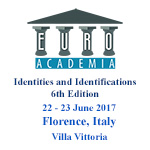Euroacademia Conferences
 Europe Inside-Out: Europe and Europeanness Exposed to Plural Observers (9th Edition) April 24 - 25, 2020
Europe Inside-Out: Europe and Europeanness Exposed to Plural Observers (9th Edition) April 24 - 25, 2020 Identities and Identifications: Politicized Uses of Collective Identities (9th Edition) June 12 - 13, 2020
Identities and Identifications: Politicized Uses of Collective Identities (9th Edition) June 12 - 13, 2020 8th Forum of Critical Studies: Asking Big Questions Again January 24 - 25, 2020
8th Forum of Critical Studies: Asking Big Questions Again January 24 - 25, 2020 Re-Inventing Eastern Europe (7th Edition) December 13 - 14, 2019
Re-Inventing Eastern Europe (7th Edition) December 13 - 14, 2019 The European Union and the Politicization of Europe (8th Edition) October 25 - 26, 2019
The European Union and the Politicization of Europe (8th Edition) October 25 - 26, 2019 Identities and Identifications: Politicized Uses of Collective Identities (8th Edition) June 28 - 29, 2019
Identities and Identifications: Politicized Uses of Collective Identities (8th Edition) June 28 - 29, 2019 The European Union and the Politicization of Europe (7th Edition) January 25 - 26, 2019
The European Union and the Politicization of Europe (7th Edition) January 25 - 26, 2019 7th Forum of Critical Studies: Asking Big Questions Again November 23 - 24, 2018
7th Forum of Critical Studies: Asking Big Questions Again November 23 - 24, 2018 Europe Inside-Out: Europe and Europeanness Exposed to Plural Observers (8th Edition) September 28 - 30, 2018
Europe Inside-Out: Europe and Europeanness Exposed to Plural Observers (8th Edition) September 28 - 30, 2018 Identities and Identifications: Politicized Uses of Collective Identities (7th Edition) June 14 - 15, 2018
Identities and Identifications: Politicized Uses of Collective Identities (7th Edition) June 14 - 15, 2018
Cross-Cultural Dialogue and Search of Identity by Léonard Foujita
-
-

-
Presentation speakers
- Kuniko Abe, Akita International University, Japan
- Download presentation
Abstract:
Recent studies of different multi-cultural networks highlight that the artists’ circulation generated a great impact on several avant-gardist movements. The ‘passage’ of artists to big European cities, such as Paris, Walter Benjamin’s ‘City of Lights’, is a good example of this phenomena. A huge number of artists from different horizons coming to settle in Paris, the world capital of art at that time, constituted ‘École de Paris’ during the three first decades of the 20th century. They were largely non-French artists, including Japanese artists who came from not ‘somewhere else’ of the West but Far-East. The Western modern world was highly challenging for Japanese artists who suffered from confrontation with the duality between cultural identity and universal artistic values, fundamentally imposed Eurocentric aesthetics. Japanese modern era – Meiji, Taisho and Showa periods – and who knew the struggle regarding a dilemma, the complex situation with perpetuation of Japanese traditional artistic values initiated by Fenollosa and Okakura contrasted with the principal governmental goal for rapid catching up to Western technology and knowledge. My paper attempts to examine Japanese painters’ awakening of Far-Eastern identity while searching for assimilation to European aesthetics with “Ideal” through their encounter of European art and spiritual dialogues with past masters works. They found their another-self in this mirror city Paris. The analysis will particularly be interested in Léonard Foujita (1886-1968) who changed his style with contact of European art and became an emblematical painter of the Ecole de Paris. What was the process of his awakening of cultural identity, through temptation of the West, while trying to pursue the universal in his art? The analysis of the awakening process of this Japanese artist after an intense dialogue with the human creative adventures, finally reveals complex artistic identity which affirmed hybrid style, fusion of the West and East, a synergy of two complementary entities, which produce a new vital spirit.
-
Related Presentations

Abolitionist Europe? The EWL, the Nordic Model and the Shaping of Norms Regarding Prostitution
- Michele Greer













